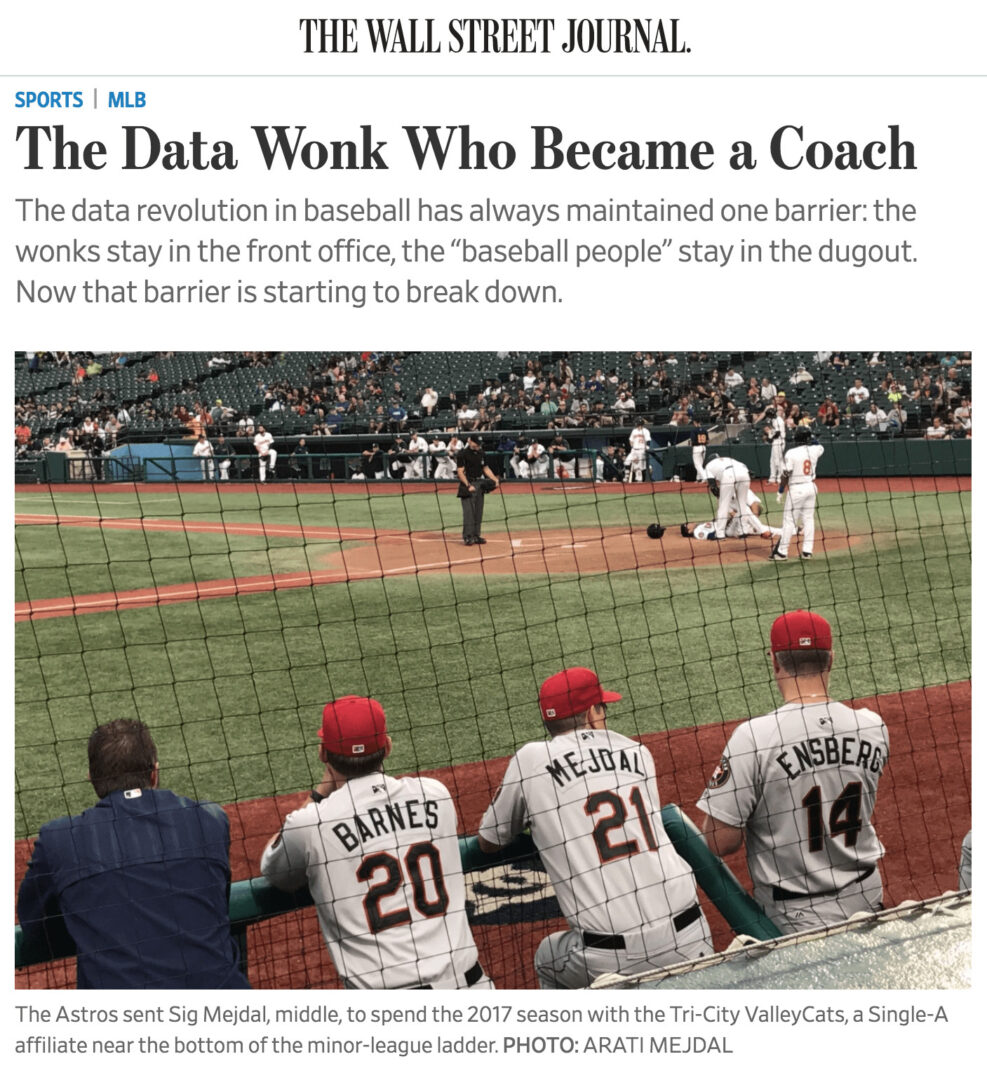As you might know, I have always enjoyed baseball and like blogging about ideas and statistics that come from the sport.
I loved this recent article from The Wall Street Journal and there are parallels to Lean and being an effective change agent:
“The Data Wonk Who Became a Coach“
As Major League Baseball gets deeper into (or beyond) the “Moneyball” era, we've seen the continued rise of “advanced analytics” and front-office specialists who crunch numbers and give advice to managers and team executives.
The WSJ article focuses on one such specialist, Sig Mejdal, “one of baseball's most respected quantitative analysts” who works for the Houston Astros organization (the team that won last year's World Series).
Mejdal used to work for Lockheed Martin and NASA, then taking a “high-level job in the front office” (the executive team) of the Astros.
This year, the Astros sent to him a different “gemba” (a Japanese term Lean people might use for “workplace” or “actual place) — the minor leagues:
“The Astros sent Sig Mejdal, one of baseball's most respected quantitative analysts, to spend the 2017 season with the Tri-City ValleyCats, a Single-A affiliate near the bottom of the minor-league ladder.”
As we see with Lean (or any new mindset or methodology) in healthcare, the old guard understandably pushes back on new ideas, especially if the new ideas are pushed or forced on people. We'd hate to see an “us vs. them” mentality when it comes to the early days of an organization's Lean journey, but Mejdal talks about the “us vs. them” mentality, saying:
“It's understandable that with one of the ‘thems' coming in, there is going to be pushback.”
As I've learned and have been writing about (and talking about), we shouldn't blame individuals for “pushing back” or “resisting change.” We need to respectfully engage them instead of pushing them away.
The article talks about players and others having challenges with change:
“Upon taking over as the Astros' general manager in December 2011, Jeff Luhnow quickly learned that the people on the field don't always respond positively to radical new concepts. The Astros frequently faced what Luhnow described as “implementation challenges that we didn't anticipate.” An early adopter of the defensive shift, for instance, Luhnow remembers “pitchers that would glare at the dugout” when groundouts in a normal alignment scooted through the reconfigured infield.”
Does this remind you of what often happens when you introduce Lean to the organization? Do people get upset and glare when they don't understand changes or the reasons behind the changes.
What can the Astros do to engage their players and bring them along in the change process?
One thing they are doing is educating players earlier in their careers. Maybe there is a parallel to teaching medical students about Lean and giving them an early introduction (note: I didn't say “indoctrination”).
“To combat that problem, the Astros added full-time “development coaches” in the minors, a hybrid position between typical baseball training and analytics. The candidates for that job, Luhnow said, needed “to be able to throw batting practice, hit a fungo and program a SQL.”
Those efforts went well, so the Astros decided to send Mejdal to “the front lines” of a low-level minor league team.
“So much of our knowledge is still theoretical,” said Mejdal, who the Astros now call a special assistant for “process improvement.” “This was a clear attempt to turn that from theoretical into experiential knowledge.”
Process improvement? In baseball? Wow.
In our Lean efforts, we often have to turn “theoretical knowledge” from books, such as “smaller batches are better,” into experiential knowledge, such as determining how small of a batch size is practical given current constraints in our process.
I've seen people get themselves in trouble when they take a theoretical concept and turn it into an absolute, such as “one-piece flow” or “zero inventories.” We often need to take intermediate steps, such as reducing lab specimen collection batch sizes from 10 to 5, then to 3… and maybe that's the smallest practical batch size that works in our current environment (which isn't an excuse to never change the structure or environment). We might make a short-term compromise in the name of long-term progress.
Mejdal was assigned to the team's manager, former MLB player Morgan Ensberg.
“It helped that he had the unwavering support of Ensberg, who said that a manager put into that situation unwillingly could “completely Deep Six” an intruder like Mejdal.”
This can happen in healthcare. If an internal process improvement coach is assigned to a department where the leader doesn't want them, the PI person might be shunned and have nothing to do. Or, the PI person will get locked into an “us vs. them” battle that probably never ends well. This can happen to outside consultants if they are put in a situation that doesn't have fertile soil for Lean (it has happened to me).
I saw this happen at GM when the GM Powertrain division hired people from Toyota suppliers assigned them to my plant, where leadership didn't want them. The specialists were shunned and banished to the mezzanine level, where they often sat and played cards.
But, Ellsberg was willing (or was willing to try) to have Mejdal helping him.
Ellsberg is now a believer – based on experience, not theory:
“If I were ever blessed enough to become a major-league manager, I would have an analyst on the bench,” Ensberg said. “The person that needs to push this through and believe it is the manager.”
Mejdal isn't making decisions. That's usually the case with Lean or P.I. coaches. You're asking questions, challenging the status quo, and making recommendations. Hopefully, that's all welcome.
Some appreciate the fresh eyes (as we ofetn see with Lean):
“It's amazing the things somebody who may not have a background in baseball picks up on,” Mushinski said.
A coach can be effective in helping others, even if they haven't “played the game” or if they haven't done the job of the person they're coaching.
“The idea is not to have this separation between us and them,” Luhnow said. “Just because one person stopped playing baseball in middle school and another person played 10 years in the big leagues doesn't mean they can't work together collaboratively to help players get better.”
That's what a healthy and constructive coaching relationship should be like in any setting. The coach has to be welcomed. Those being coached should be open to new ideas. Small tests of that coaching relationship can lead to the coach becoming a trusted advisor to the leader who is actually making the decisions…
What thoughts does this spark in you? Please post a comment and share in the discussion.
Please scroll down (or click) to post a comment. Connect with me on LinkedIn.
Let’s work together to build a culture of continuous improvement and psychological safety. If you're a leader looking to create lasting change—not just projects—I help organizations:
- Engage people at all levels in sustainable improvement
- Shift from fear of mistakes to learning from them
- Apply Lean thinking in practical, people-centered ways
Interested in coaching or a keynote talk? Let’s start a conversation.










